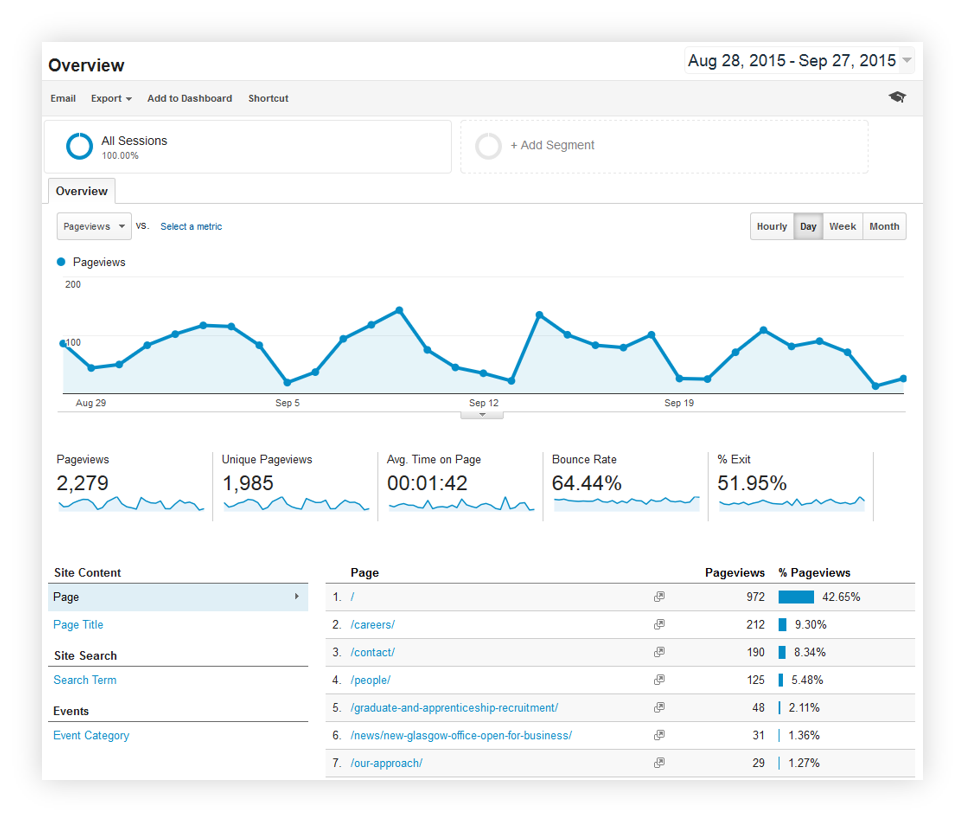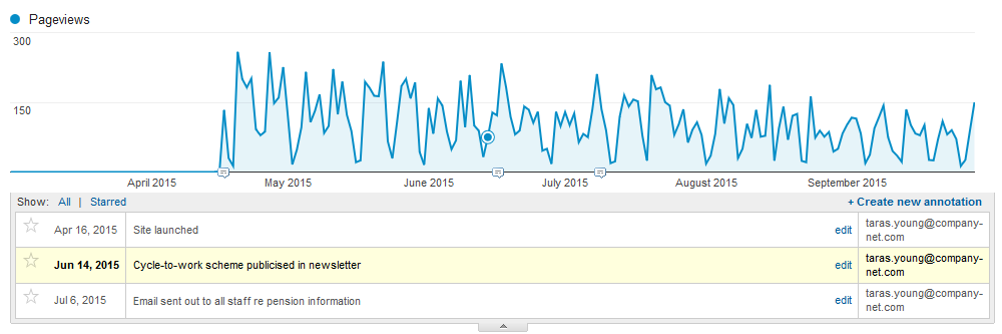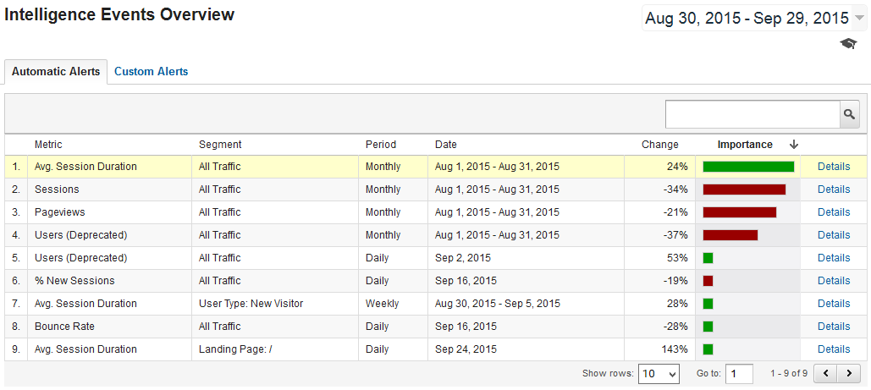Keeping tabs on intranet usage helps underpin continuous improvement, and is fundamental to getting value out of your investment. Get deeper insight by combining SharePoint usage reports with Google Analytics.

Why bother with analytics?
Collecting and analysing usage data should be a priority for every organisation with an intranet. It’s a powerful way of increasing the value of your investment and driving continuous improvement.
Monitoring your intranet analytics lets you keep track of things like:
- What areas of the site are most popular
- What parts of the site are unpopular – and why
- User adoption – whether overall site visits are increasing, have plateaued, or are in decline
- Any sudden or slow-burning problems
- Typical user journeys
By analysing how people are using your intranet, you can target content more effectively, develop a structure for your site that better reflects user needs, and identify and resolve user challenges before they become problems.
What’s wrong with the built-in usage reports?
SharePoint’s built-in analytics – known as usage reports – capture only a very limited amount of information about what’s going on.
Data is gathered on two aspects: site usage, and search usage. Site usage collects data measuring how many times a page is visited each day, and how many unique users visited that page. It then exports that data to an Excel spreadsheet. From that data, you can see how many individuals used the intranet, and how many times pages were visited, but not much else.

The search usage report gives you some more useful measurements. As well as total number of search queries and the most popular search terms, this report can give you data about:
- Abandoned queries – searches where people didn’t click on a result;
- Queries that returned no results;
- Stats on query rules you’ve set up, such as how many times people clicked a promoted search result.
On an intranet solution where a powerful search engine is integral to the system, such as Kira, this information can help you better understand what people are most commonly looking for – and what’s missing.
While these reports are useful, the data they offer is quite shallow, and, as simple Excel spreadsheets, they don’t give you an intuitive way of playing with the data to gain real and unexpected insights. While we understand Microsoft are working on improving the analytics capabilities of SharePoint online, there is already a powerful solution available that will give you a detailed picture of your intranet users… and it’s free.
Enter Google Analytics
You can achieve more comprehensive results by combining SharePoint’s reports with Google Analytics. While it’s aimed primarily at public-facing websites, it does actually work on internal SharePoint sites, too. This product from the web search giant collects very detailed data, and combines it with industry-leading analysis tools that let you drill down into your visitors’ actions, needs and motivations.

Some key features include:
- Detailed, in-browser reports about many aspects of your site.
- Custom reports that can be exported to Excel or PDF – perfect for sharing with your team or board.
- Custom dashboards, giving an instant overview of key metrics.
- In-page analytics, a tool which overlays data such as number of clicks directly onto the page in your browser.
- Real-time analytics, a dashboard giving you a live view of what visitors are doing.
- Graphical user journeys, showing the routes visitors take through your site.
Not only can you filter everything by date range, but you can segment any page of data by any facet. For example, you could choose to focus on visitors who accessed your intranet using a smartphone, who spent more than 5 minutes on the site, last Wednesday lunchtime. Segments are saved in Google Analytics, and can be applied to any report.
What is it good for?
When people visit
Google Analytics reports can provide data on visits as granular as hour-by-hour. You can use this to discover what times and what days people are using your intranet the most. A communications team could use that data, for example, to plan when to release a key piece of news.
What people visit
It’s also easy to find out what pages are most popular, as well as being able to track common user journeys through the site. From that information, you can infer what people are actually using the intranet for. By analysing ‘drop-offs’ – points at which people leave the site – you can also spot and resolve any problems.
Why people visit
Your data can be annotated with notes to remind you when a particular event happened, whether that’s a new page going live on the intranet, or something happening in the wider business that has a far-reaching impact. That way, you won’t be left scratching your head about why there was a spike or dip in usage when you look back over your stats months later.

How people visit
Modern intranets, such as our Kira intranet, are designed from the ground-up to work with mobile devices like smartphones and tablets. Google Analytics lets you see what devices people are using to access the site, down to the level of specific models, such as an iPhone 7 or Samsung Galaxy S7. This can be vital information for deciding the shape of your content, and should influence any future changes to your intranet’s structure or design.
You can also view a report on site speed, which reveals how quickly users are able to access page content. From a technical point of view, this lets you spot issues that might be slowing down the intranet experience – such as having too many large images on a page, or elements hosted by unreliable third-party sites (such as videos or forms).
Going further, you can set up ‘intelligence events’ to alert you if something seems awry in usage patterns. If the system spots an anomaly in traffic, such as a large drop in number of visits, it can automatically trigger an email alert to allow the problem to be investigated. This goes for positive events, too – for example, you could set up an alert to notify you if a page received an unusually high number of views.

Risks and considerations
By installing Google Analytics, you’re technically inserting a piece of third-party code onto every page of your intranet. Since data intranet usage will be stored on Google’s servers, this approach assumes you trust Google to secure their own infrastructure. In practice, millions of websites and intranets around the world use Google Analytics, so the risk here is very low, but it’s worth bearing in mind.
A question we are sometimes asked is whether it’s worth paying for Google Analytics Premium. The short answer is that the licence is rumoured to cost in excess of £100,000 per year – we don’t know for sure, as we’ve never got to the point of asking. So unless your business is comfortable with that figure, the standard, free version should more than meet your needs.
Not everything will work!
Remember that Google Analytics is designed for public-facing websites, not intranets, so not all of its features will work or be relevant. For example, data about user demographics – age, gender, interests and purchasing habits – is drawn from Google’s DoubleClick advertising network, which is unlikely to be available unless your staff routinely browse the intranet from their personal devices (or spend a lot of time shopping online at work, in which case you have a bigger problem).
Geolocation features – mapping where visitors are located – is also unlikely to work, since it relies on Google being able to see the user’s external IP address. If you have multiple offices around the world, and each has its own local IP address, then this could provide valuable insight into regional usage. Generally speaking, though, everyone visiting from your organisation’s offices and your corporate VPN will appear as on one IP address, negating the usefulness of this feature.
The tool also has a benchmarking feature, which is designed to compare your site to others in the same category. This is designed for normal, public-facing websites – not intranets – so, again, you won’t get much useful data out of this tool.
It’s difficult to identify individuals on Google Analytics, although as of recent version it’s no longer impossible. In fact, it’s potentially easier to do so with an intranet than with a public website, since every user on your intranet must have authenticated in order to access the site. However, unless you have a good reason to track individuals around your site, adding this functionality would be a costly and unnecessary piece of work.
Finally, features like Google AdWords integration and eCommerce tracking are present, but aren’t relevant to intranet usage and can therefore be ignored.
Better together?
While it’s clear that Google Analytics offers a broader range of data and tools to gain deeper insight, you shouldn’t write off SharePoint’s built-in usage reports. Because SharePoint has direct access to its own page view data, the site usage report can act as a useful comparator to make sure Google isn’t getting it wrong. And the search usage report provides information taken from SharePoint’s built-in search engine that Google can’t access.
The best route is to take all the available data together – SharePoint and Google Analytics – and use it better inform the decisions you make about your intranet’s content, structure and design.
